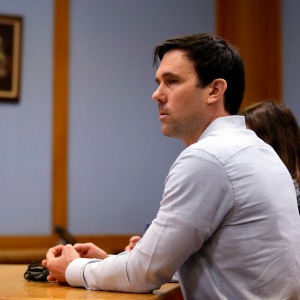Editorial: The history behind Vermont’s education funding mess

Ray Ballou, director of technology and communications for the White River Valley Supervisory Union, left, runs the video conference for an information session on Act 127 at the WRVSU offices in Royalton, Vt., on Friday, Feb. 23, 2024. Four peopld outside of the office attended remotely. (Valley News - James M. Patterson) Copyright Valley News. May not be reprinted or used online without permission. Send requests to permission@vnews.com. James M. Patterson
|
Published: 03-01-2024 9:31 PM
Modified: 03-04-2024 7:39 PM |
This year’s school budgeting chaos in Vermont has been justly attributed to well-intentioned legislative bungling. But revisiting the creation story of the state’s school funding system may provide useful context.
In the beginning was Brigham. In 1997, the Vermont Supreme Court ruled in Brigham v. State of Vermont that all children in the state were entitled under the Vermont Constitution to substantially equal educational opportunity; and that it was the state’s responsibility to afford that opportunity.
The court invalidated the school funding system then in use, which depended heavily on local property taxes supplemented by some state aid, because it resulted in wide disparities in revenue available between property-rich and property-poor school districts. Wisely, it left it up to the Legislature to devise a replacement.
Which it did. Act 60 and its successors have been largely successful in equalizing educational opportunity while preserving a substantial measure of local control. With that said, the funding system has flaws that became evident soon after enactment. First and foremost, it is mind-numbingly complex. Any system of taxation that cannot be clearly explained in a few sentences is bound to be viewed warily by those paying for it. Moreover, as a result of that complexity, it is very hard to tell beforehand what effect local school budget decisions will have on tax rates.
Very roughly speaking, the system depends heavily on two categories of statewide property taxes: A homestead rate assessed on a primary dwelling and surrounding land, which for about 70% of households is adjusted according to their income by means of a property tax credit; and a non-homestead rate levied on commercial and industrial property, second homes, rentals and the like. The tax rates are set each year by the Legislature, and together they yield about 65% of the revenue expended by the state Education Fund, which constitutes the aggregate of all local school spending decisions in the state. The bulk of the remaining revenue comes from the sales tax, supplemented by the rooms and meals tax and other smaller sources.
One complicating factor is that it costs more to educate some students than others. So in pursuit of equal educational opportunity, the Legislature has accounted for this by assigning “weights” to various categories of students, such those in high school, those who come from impoverished backgrounds and those for whom English is a second language.
The most recent version of the funding formula, Act 127 of 2022, rejiggered this weighting mechanism with an eye to more accurately reflecting current student needs and costs. This stood to benefit some districts but penalize others, which would have to raise more in taxes to maintain their operating budgets. To smooth that transition, Act 127 contained a 5% cap on homestead tax increases for the first five years of its implementation, so long as districts kept spending increases under 10%.
Although this cap was apparently intended only for districts on the losing side of the reweighting, nobody got the memo — perhaps because the state has been without a permanent education commissioner for nearly a year. The not surprising result was that, depending on your point of view, districts all over the state either larded their budgets for the coming year with extra spending or seized the opportunity to make up for expiring pandemic-era financial aid and expanding student needs. The unprecedented levels of spending threatened to break the Education Fund bank and lead to sky-high tax rate increases.
Article continues after...
Yesterday's Most Read Articles
Unfortunately, by the time this dawned on legislative leaders, many districts had already finalized their budgets to present to voters. So when the lawmakers scrambled and repealed the tax cap late last month, they also had to give districts permission to delay their budget votes from Town Meeting day. Several Upper Valley districts have taken advantage of that opportunity, rescinded their budgets and gone back to the drawing board.
Certainly, this tax-cap debacle is an abject failure by the Legislature to anticipate consequences that should have been fairly easily anticipated. But in some ways, it seems to us that the seeds were sown after Brigham, when the Legislature attempted to retain a large measure of local control over school spending even though under Brigham it was now state’s responsibility to guarantee, and pay for, equal educational opportunity. Somehow spending decisions became remote from funding sources.
We agree with legislators who suggest that it’s time to rethink the whole system. Our ideas on that score will appear in this space in due course.

 Editorial: Parker parole a reminder of how violence reshapes our lives
Editorial: Parker parole a reminder of how violence reshapes our lives Editorial: Chris Sununu’s moral vacuum
Editorial: Chris Sununu’s moral vacuum Editorial: Gambling tarnishes America’s sporting life
Editorial: Gambling tarnishes America’s sporting life By the Way: A white nationalist’s many mistruths
By the Way: A white nationalist’s many mistruths
